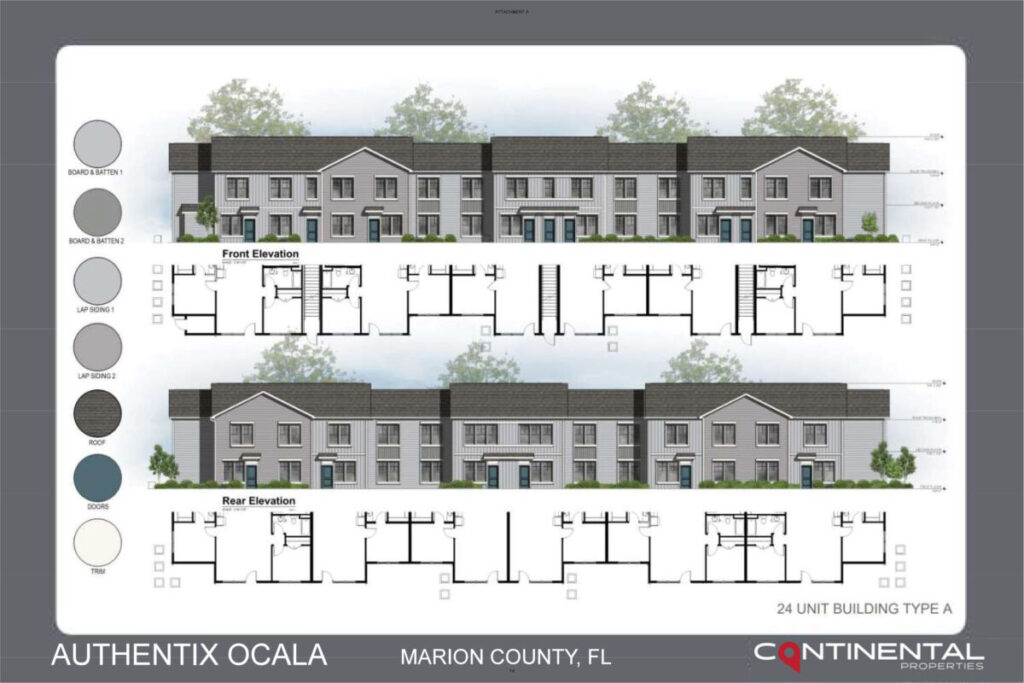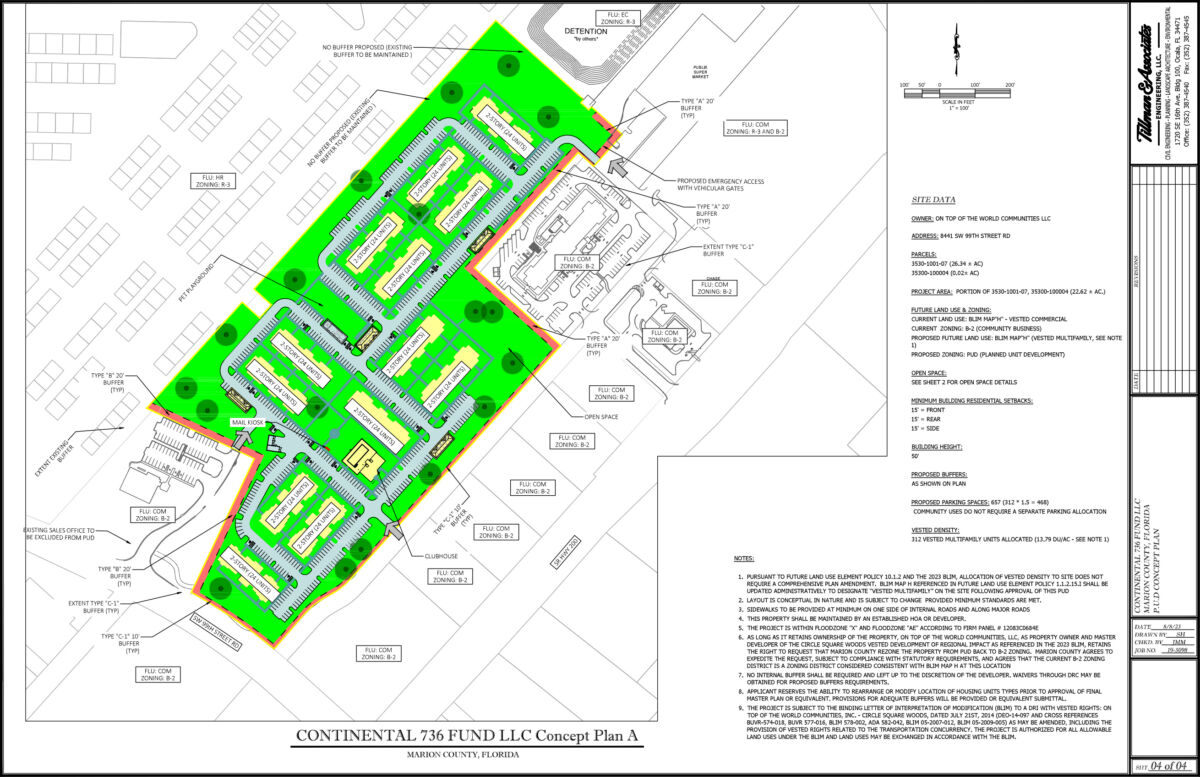BOCC votes 4-1 to approve 312-unit apartment complex at On Top of the World
An unusual hearing included a pre-meeting prayer, food trucks, and discussion of vested development rights in a mix of developer representatives, county staff and OTOW seniors.

A public hearing on April 22 for rezoning of a parcel near the entrance to On Top of the World had several unusual aspects, starting with a prayer from Marion County Commission Chair Michelle Stone that asked for wisdom, patience and acceptance of the outcome even if “we do not agree.”
Stone’s prayer previewed the 4-1 vote by the commission to approve the request to rezone the parcel from B-2 (business) to a planned unit development (PUD) put forth by OTOW and apartment complex developer Continental Properties. Stone was the sole dissenting vote.
The county emailed opponents on Friday, April 19, reiterating that the developer’s vested rights do not allow the commission to deny the request.
The day was also unique in that the county brought in two food trucks in anticipation of extensive attendance and public comment from the affected senior residents from OTOW. Big Rascal BBQ and Chick-fil-A food trucks set up in the parking lot, and the seven-plus-hour meeting had a formal lunch break.
County attorney and staff previewed vote
County Attorney Guy Minter gave a 20-minute report focusing on the legal concepts of vested development rights and Vested Development of Regional Impact (VDRI) that were involved with the re-zoning request.
“Regular legal standards may not apply,’’ he said. “There are certain legal aspects of what we’re dealing with today that do not apply to the average zoning case that comes before the board. This is a master-planned, mixed-use project development that has been in the process of development in Marion County for 50 years.”
Minter was referring to the overall OTOW project, comprising thousands of acres off State Road 200 and SW 80th Avenue and a slated build-out of over 32,000 homes. In addition to residential units, several commercial sections of the overall acreage have been developed.
“Florida statutes… have provisions that once a developer has certain vested rights under a VDRI, the board has no authority to take those vested rights away. In this case, going back to 1973, the developer had B-2 zoning, which allowed multi-family zoning,” Minter said.
The board, he continued, is “constrained on whether they can deny a multifamily use on this particular parcel or the density requested” as those already have been established.
Minter pointed out that a “straight B-2 zoning” would allow the developer to do almost anything with the parcel; in contrast, a PUD application can be revised with board input regarding the site layout, amenities, required buffers and more. The board has discretion to deal with these revisions, he said.
“These kinds of things can lead to all kinds of litigation” if the board ignored statutes, he said, and the county could be sued.
County staff gave a general overview of the application, and then Senior Planner Chris Rison discussed VDRIs, mentioning the 1973 Vested DRI of Circle Square Woods and the town center concept used in various OTOW neighborhoods and sections. Rison made it clear the VDRI was implemented before the county’s current Comprehensive Plan that was put in place in the 1990s.
Marion County has other VDRIs including Oak Run, Spruce Creek, Stonecrest and the Village of Rainbow Springs. There are also other examples of multifamily complexes next to single-family neighborhoods, including the Heath Brook area near the Market at Heath Brook shopping complex with multiple apartments, and the in-progress Spires 27 on U.S. 27, situated between Ocala Preserve and Quail Meadow, both 55-plus communities.
Staff recommended approval of the zoning change with 13 conditions to modify the PUD. These included requirements for compliance with the Land Development Code and no more than 312 units; a full traffic study; an additional multimodal path to allow for golf carts, bikes and pedestrians; and a “no-touch” buffer of the existing green space and vegetation present on the parcel’s north side.
The applicant’s various representatives gave their presentations for over 90 minutes. One observer commented, as audience members began to leave, “They’re getting fatigued by the process.”
The audience reacted vocally at several points, particularly at a comment that the OTOW single-story villas were “rental property” and that the current tree line is opaque and will block the view in and out of the apartment complex.
Faced with the notion that the commissioners’ hands are tied, Stone asked, “This is a developer that already has the right, that already has everything in place to say it should be approved. Why must this board come into play with anything?”
Jessica Icerman, attorney for the developer, said, “We are vested as to use and we are vested to density; there are other components that are open for discussion. The vested B-2 zoning standards don’t have the restrictions for residential usage. We need your input and approvals for the additional standards” regarding residential usage, buffers and access points, she said. The 1973 B-2 zoning had no details or provisions for housing on the parcel.
Minter spoke to the idea of “grandfathering” and reiterated that the government can’t take away a developer’s vested rights.
Opposition speakers thoughtful and got “The best win we could get”
The county reported receipt of 297 opposition letters, and two in support of the project, after 100 nearby neighbors had been notified of the hearing.
Attorney Joseph Shoemaker, representing the OTOW residents opposing the rezoning, focused on residents’ concerns about a potential increase in crime as well as changes to access OTOW property; the differing needs of all ages versus a seniors-only community; the potentially dangerous mix of cars, skateboards, bikes and golf carts on roads and pathways; that nearly 7,000 dwelling units have already been approved in the area; and whether the apartments are needed at all.
Shoemaker finished with several requests for revisions to the PUD to enhance safety and noise issues.
OTOW opposition speakers—toting photos, graphics, Ocala Police Department crime statistics, fire/rescue needs and other materials—followed Shoemaker with detailed presentations to the board.
One speaker’s testimony was comprised of direct quotes from previous BOCC meetings, reading back the commissioners’ own words to them regarding other developments and county needs. Another stated, “We count on you to protect us. Senior lives matter.”
Several speakers mentioned the incompatibility of children living near the 55-plus neighborhood and the danger of being so close to busy SR 200. One speaker was in tears talking about the prospect of a child running into traffic on the highway where the speed limit is 50 mph, but people routinely drive faster despite the traffic congestion in the area. Another asked how school buses would navigate the complex and expressed worry about children waiting for buses near or having to cross SR 200.
Opposition testimony lasted over 90 minutes, and the board started its discussion.
All the board members had questions for the applicant, suggestions for ways to change the project and other concerns. The board, staff and the developer’s representatives then hammered out several major changes to the PUD. The major revisions were: a limitation of two-stories and 35 foot height; two access points to the complex, adding one to the east side near the Publix; that the multimodal path would be placed on the north side of the spine road; a buffer on the north side composed of a 2-foot high berm topped with a 6-foot-tall vinyl fence to block out light and noise; and the addition of carded golf-cart gates to protect entrance into OTOW, to be paid for by the developer.
Stone was against the general concept and said vehemently, “If they believe it’s appropriate, that’s on them. I don’t believe it’s appropriate” for OTOW to have a multiage complex so close.
Commissioner Craig Curry discussed the balancing act the BOCC had in the matter.
“They can go straight zoning and out of the PUD, and we (would) have no say in it,’’ he said. “Look, we’re just getting out of a $20 million lawsuit on another property. This one is lined up to be another one. Whether I like it or not, they have the vesting rights. If they sue us, they are gonna win. At least a residential-type environment is better. I’d rather work with them on trying to determine what’s the best way to build this project out” and still protect the seniors.
“Yes, we can vote no on it, and if we do, we’re going to court,” Curry summarized.
Commissioner Carl Zalak reminded the audience that the developer can move the dwelling units and the commercial around within the DRI. Referring to the Colen family, developers of OTOW, he said, “Overall, you all live there because he’s done things right. What the board is doing today is we’re making rules over what the buffer looks like and what the transportation and ingress/egress look like. It’s better for us to plan the buffer and access.”
As the afternoon wore on, audience members began to leave the meeting. When the vote came, fewer than 70 people remained in the auditorium at 3:40 p.m.
OTOW resident reaction
Nancy Carp, a neighborhood organizer for OTOW residents, reacted to the vote after the meeting.
“We were realistic going in knowing the odds were against us, being the land is vested,” she said. “That being said, we the residents definitely had an impact. The commissioners listened to our concerns through our emails, petitions and testimonies. They asked great questions of the developers, where I can say they empathized with us but were in a legal bind.”
Carp was encouraged by the changes the board made.
“It wasn’t a total loss since concessions that we proposed—like turn lanes, buffers and golf cart security—were insisted on by the commissioners at no cost to OTOW residents,’’ she said. “That’s a win in my book in a very difficult situation.”
Stephen Hluchany, a key organizer of the OTOW residents, was less sanguine about the outcome.
“If we didn’t do what we did,” he said, “OTOW residents would have gotten absolutely nothing. The commissioners, the applicant and the developer have turned their back on residents of OTOW. What we asked for in those contingencies was very basic and minimal. It should have been offered right up front.”
Hluchany characterized the meeting as “well-choreographed” and said of the residents near the SR 200 corridor: “They’ve awakened a sleeping giant.”






